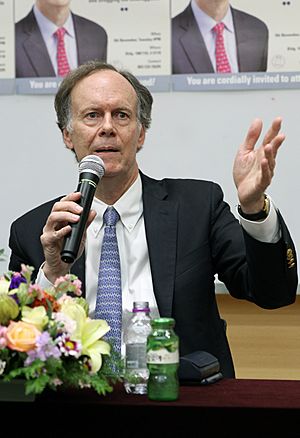William Kaelin Jr. facts for kids
Quick facts for kids
William Kaelin
|
|
|---|---|

Kaelin in 2019
|
|
| Born | November 23, 1957 New York City, New York, U.S.
|
| Education | Duke University (BS, MD) |
| Spouse(s) | Carolyn Scerbo |
| Awards | Albert Lasker Award for Basic Medical Research (2016) Nobel Prize in Physiology or Medicine (2019) |
| Scientific career | |
| Fields | Oncology |
| Institutions | Dana–Farber Cancer Institute Harvard University Howard Hughes Medical Institute |
William G. Kaelin Jr. was born on November 23, 1957. He is an American doctor and scientist who won the Nobel Prize. He teaches medicine at Harvard University and works at the Dana–Farber Cancer Institute. His research team studies special proteins that help stop tumors from growing.
In 2016, Dr. Kaelin received the Albert Lasker Award for Basic Medical Research. This is a very important award for medical research. He also won the Nobel Prize in Physiology or Medicine in 2019. He shared this prize with two other scientists, Peter J. Ratcliffe and Gregg L. Semenza.
Contents
Early Life and Education
William Kaelin was born in New York City. He went to Duke University where he studied math and chemistry. He then earned his medical degree (MD) from Duke in 1982.
After medical school, he trained in internal medicine. He then specialized in oncology, which is the study of cancer. He did research at the Dana–Farber Cancer Institute (DFCI). There, he became very good at studying how certain genes can stop cancer. In 1992, he started his own lab at DFCI. He focused on types of cancer that run in families, like von Hippel–Lindau disease. He became a professor at Harvard Medical School in 2002.
Career in Cancer Research
In 2008, Dr. Kaelin became an assistant director at the Dana–Farber/Harvard Cancer Center. His work at Dana–Farber has focused on understanding how changes in genes can lead to cancer. These genes are called "tumor suppressor genes." They normally help prevent cells from growing out of control.
His main work has been on important tumor suppressor genes. These include the genes linked to retinoblastoma, von Hippel–Lindau disease, and p53. His research has been supported by many groups. These include the National Institutes of Health and the American Cancer Society.
He also helps guide important cancer research groups. He is on the board of directors for Eli Lilly. He is also part of the scientific advisory committee for Stand Up to Cancer.
Discoveries About Oxygen and Cells
After his special training, Dr. Kaelin started his lab in 1993. He wanted to learn more about how to stop tumors. He became very interested in Von Hippel–Lindau disease (VHL). People with VHL disease often get tumors that create new blood vessels. These blood vessels produce a hormone called erythropoietin (EPO). EPO is part of how our bodies react when there isn't enough oxygen. This condition is called hypoxia.
Dr. Kaelin thought there might be a link between VHL tumors and how the body senses oxygen. His research showed that in people with VHL, certain genes are supposed to make a protein that is key to the EPO process. But a gene change in VHL disease stops this protein from working right.
Dr. Kaelin's work matched discoveries made by Peter J. Ratcliffe and Gregg Semenza. They had found a two-part protein called hypoxia-inducible factors (HIF). HIF is very important for making EPO. It gets activated by the amount of oxygen in the blood. Dr. Kaelin found that the VHL protein helps control HIF. If the VHL protein isn't working, HIF can make too much EPO. This can lead to cancer.
The combined work of Kaelin, Ratcliffe, and Semenza showed how cells in our bodies sense and react to oxygen levels. Their discoveries have helped create new medicines. These medicines can help people with conditions like anaemia (low red blood cells) and kidney failure.
Personal Life
William Kaelin was married to Carolyn Kaelin, who was a breast cancer surgeon. They were married from 1988 until she passed away in 2015. They had two children together.
Awards and Honors
Dr. Kaelin has received many important awards for his scientific work.
- NIH Physician-Scientist Award (1990)
- Canada Gairdner International Award (2010)
- Elected member of the National Academy of Sciences (2010)
- Stanley J. Korsmeyer Award (2012)
- Wiley Prize in Biomedical Sciences (2014)
- Albert Lasker Award for Basic Medical Research (2016)
- Massry Prize (2018)
- Nobel Prize in Physiology or Medicine (2019)
See also
 In Spanish: William Kaelin Jr. para niños
In Spanish: William Kaelin Jr. para niños


